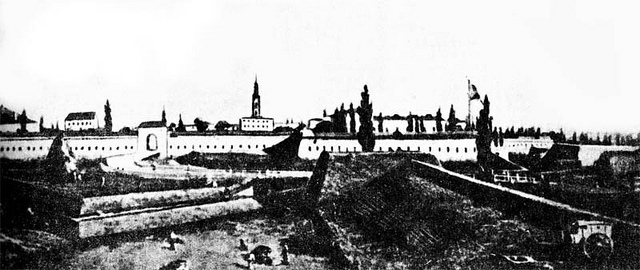
Location: Babruysk Map
Constructed: 1810- 1836

Babruysk Fortress is a historic citadel situated in a Belarus city of Babruysk. Most of the historic castle was demolished and today lies in ruins. First Babruysk Fortress dates back to the Middle Ages. Original castle existed on the right bank of the Berezina River since the 14th century. As the military warfare changed so did military fortifications. Babruysk Fortress had to improve and much of the old structure was demolished to make way for a new fortress.
Babruysk Fortress was constructed between 1810 and 1836 by the orders of the Russian Emperor Alexander I and under supervision of military engineer Teodor Narbutt. Babruysk Fortress was erected over a course of two decades incorporating parts of the older Polish fortress and Babruysk Jesuit Monastery. In the early 20th century the fortress lost much of its military significance and was turned into jail. During Russian Civil War Babruysk Fortress served as a concentration camp for the Polish occupation forces between 1919 and 1920 resulting in over 1000 deaths. During World War II it again was turned into concentration camp by the occupying German forces. Over 80,000 Soviet citizens were killed here. Much of the Babruysk Fortress lies in ruins spread over a large area.
In anticipation of
a possible war with Napoleon, in March 1810, Minister of War Barclay
de Tolly presented to Emperor Alexander I a memorandum - “On the
Protection of the Western Limits of Russia”. The note outlined a
plan for preparing the western regions of the Russian Empire for
war, and proposed new defensive fortifications as bridge
fortifications. The construction of new fortresses was supposed to
close the gap with a width of 1200 versts between the existing
fortresses of Riga and
Kiev.
It was supposed to lay
fortifications in Dinaburg, Rogachev and Bykhov. After inspecting
the western border and reconnaissance of the area, Major General of
the Engineering Corps Karl Opperman, having examined the ideas of
lieutenant engineer Theodor Narbutt, began to insist on building a
fortress on the Berezina River in Bobruisk as an alternative to the
fortress near Rogachev on the Dnieper. On June 20, 1810, Alexander I
finally approved the master plan of the Bobruisk fortress developed
by Opperman.
According to Opperman’s plan, nothing more than
the founding of the old Jesuit church, which was being rebuilt into
a Zeichhaus, should have been left over a 400-year-old city. The
entire territory of the historically formed city on the west coast
of the Berezina was assigned to the fortress. Residents were offered
free land around the fortress, where forstadts were designed.
For the new fortress, clearing the territory along the Berezina
was required. The soldiers demolished stone and wooden houses,
Catholic and Orthodox churches, a chapel, a monastery, one large and
two smaller palaces, a medieval fortress and fortifications, the
building of the town hall, and other city buildings.
The
creation of a fortress in Bobruisk began on June 4, 1810. It was
erected by thousands of soldiers and serfs of the Mogilev,
Minsk,
Chernihiv provinces. Materials were delivered from
Ukraine, Karelia,
the Caucasus, the Urals. Major General E.P. Felkersam was appointed
the builder of the fortress, and Major General Gabriel Ignatiev
commanded the troops at the construction site. According to the
design of Opperman, the fortress was planned on the right bank of
the Berezina River, at the mouth of the Bobruisk River. On the other
side of the river, it was planned to erect an advanced
fortification, and on the left bank was supposed to be located
tet-de-pon. Free land was allotted for residents around the
fortress; forstadts were designed there. The work was carried out
intensively and by the end of 1811 forts, directed to the north,
west and south, already possessed an impressive defensive force. The
main defense line of the fortress consisted of 8 bastions. In July
1811, the Bobruisk fortress was ranked as the first class of
defensive structures of the Russian Empire.
By the beginning
of the war, 344 guns were put into the arsenal of the fortress; its
garrison numbered about 4 thousand people. It was considered an
important stronghold of the Russian army on the path of the southern
strategic flank of the Napoleonic troops.
At the beginning of
hostilities, the fortress played a significant role in ensuring the
movement of the 2nd Western Army of Bagration. During their stay in
Bobruisk on July 6-8, 1812, the 2nd Army replenished food supplies
here, received reinforcements (about 1.5 thousand people), and left
the sick and wounded in the fortress, which allowed it to safely
connect with the 1st Army under the command of Barclay de Tolly in
Smolensk. Over the next four months (July-November), the Bobruisk
fortress was blocked by the Polish corps of General Dombrowski
(about 12 thousand people). Active hostilities around the city, with
the exception of hassles of small patrols on long-distance
approaches to the citadel, were not conducted. Nevertheless,
military historians note the important role of the Bobruisk fortress
in the war of 1812. Mikhailovsky-Danilevsky wrote: “The successful
choice of the place where Bobruisk was built rendered a great,
invaluable service in World War II. No fortress in Russia has ever
been as useful as Bobruisk in 1812. If there was no fortress, it
would be impossible for Prince Bagration to join the first army
before the end of August, and then it would already be in the
vicinity of Moscow. ”